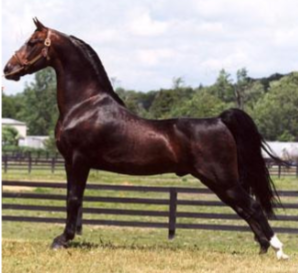Animal Science Lab Practical
1/91
There's no tags or description
Looks like no tags are added yet.
Name | Mastery | Learn | Test | Matching | Spaced |
|---|
No study sessions yet.
92 Terms
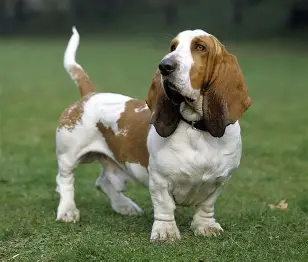
Basset hound
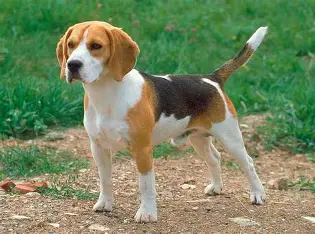
Beagle
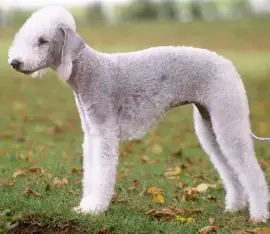
Bedlington Terrier

Bloodhound
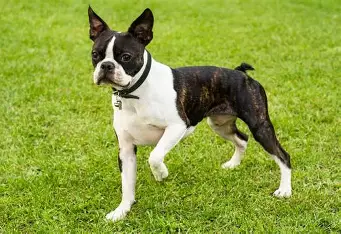
Boston Terrier
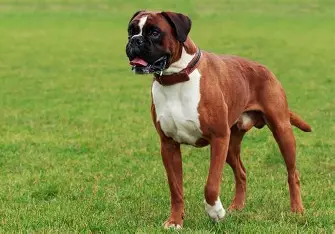
Boxer
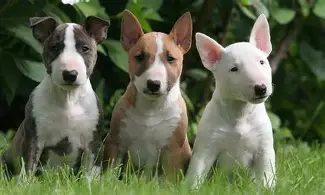
Bull terrier
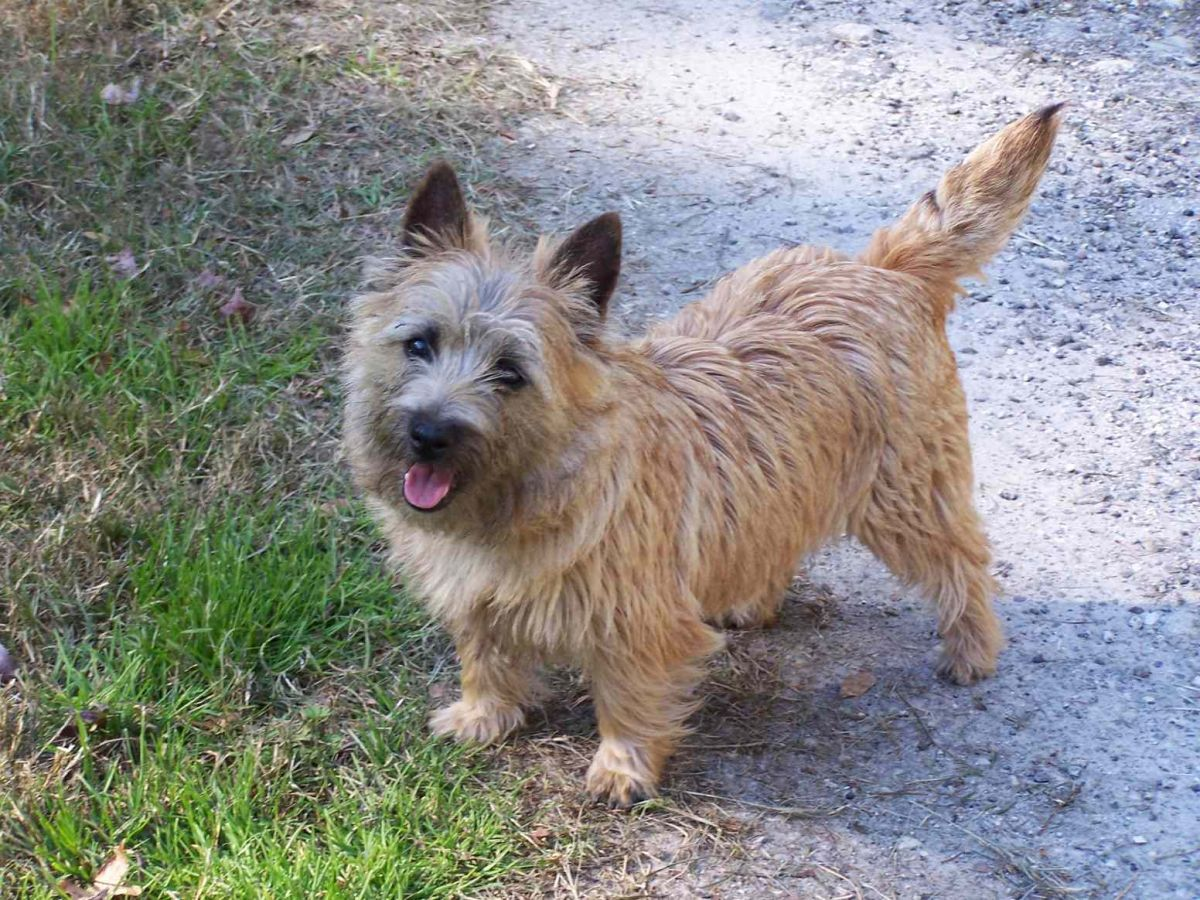
Cairn Terrier
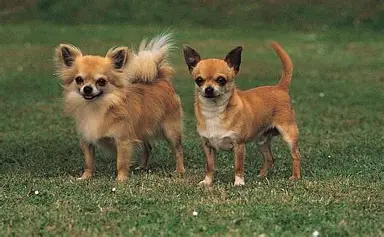
Chihuahua
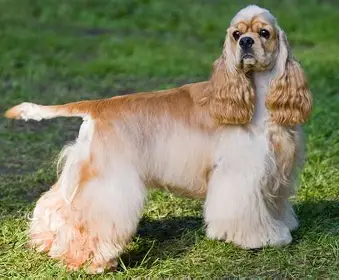
Cocker spaniel
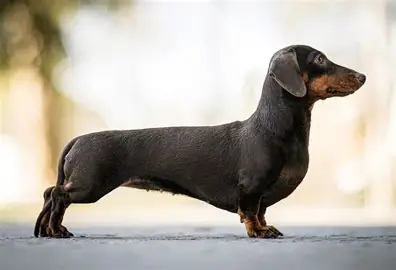
Daschund
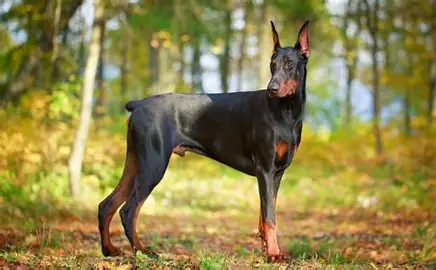
Doberman Pinscher
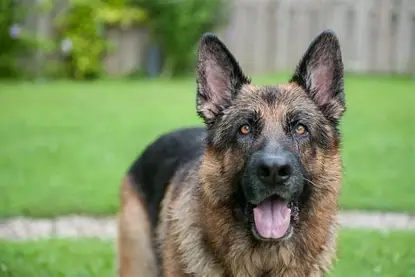
German Sheperd
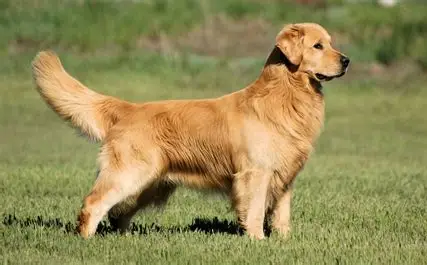
Golden Retriever
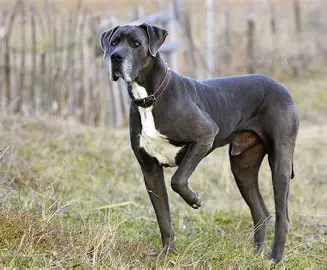
ears can be pointed or floppy
Great Dane
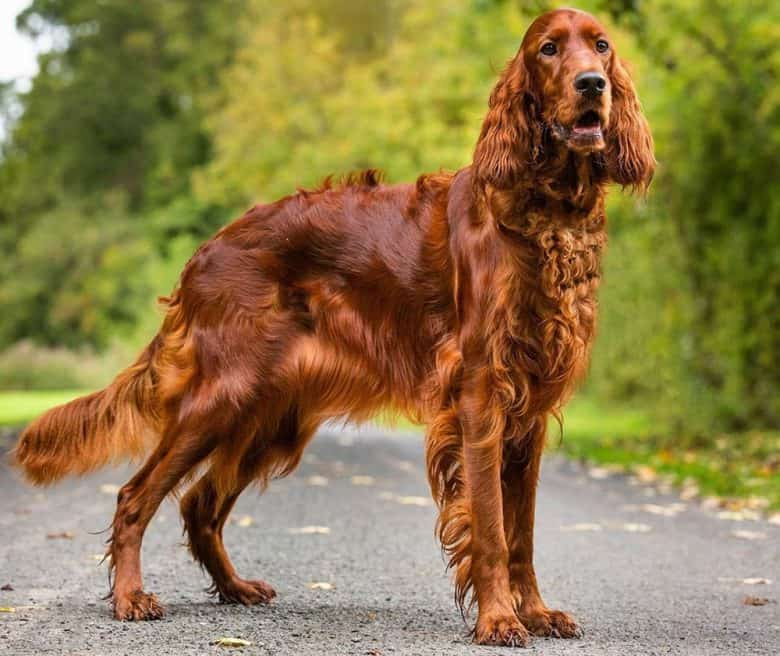
Irish Setter

Keeshond
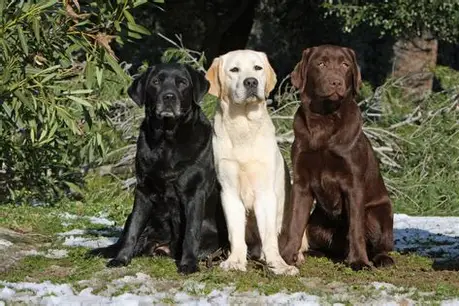
Labrador retriever
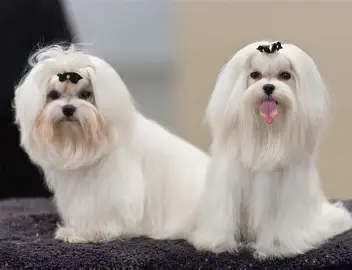
Maltese
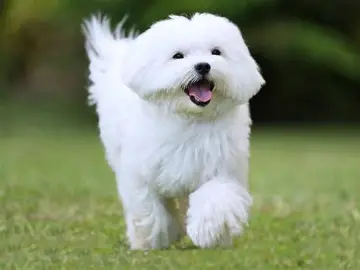
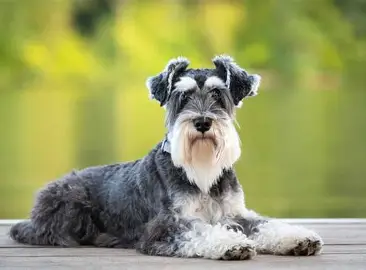
Miniature Schnauzer
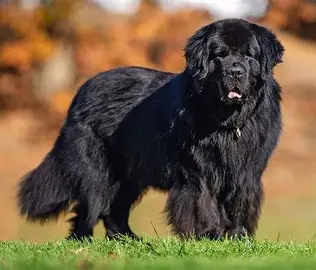
Newfoundland
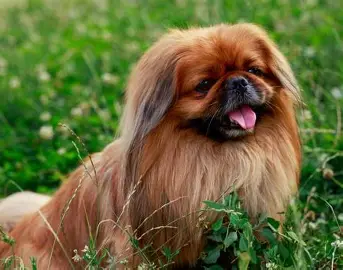
Pekinese
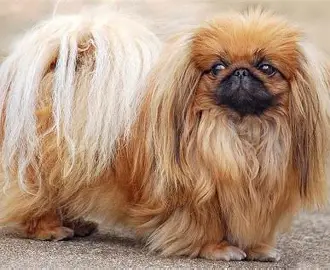
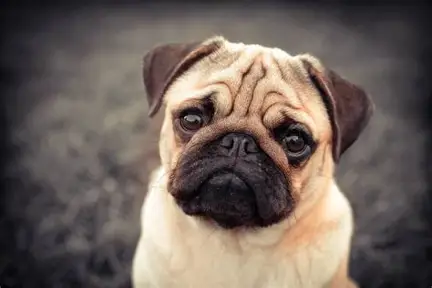
Pug
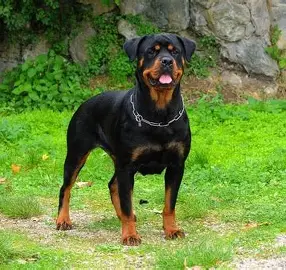
Rottweiler
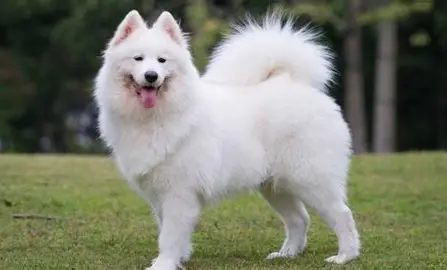
Samoyed
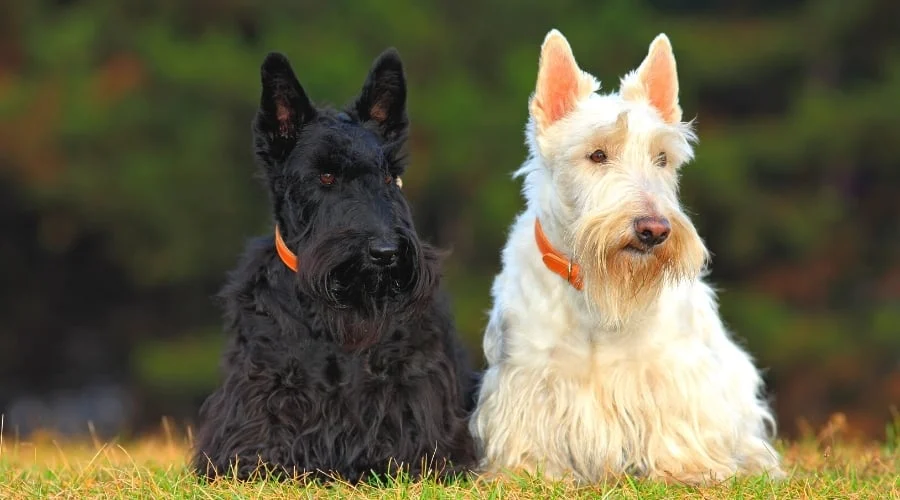
Scottish Terrier
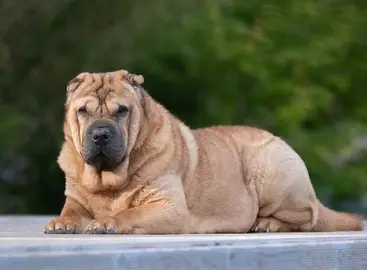
Shar-pei
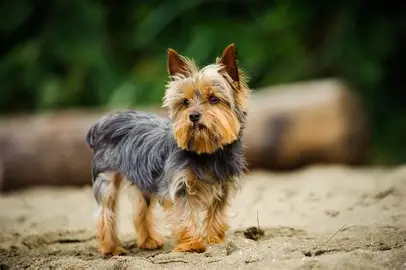
Yorkshire terrier
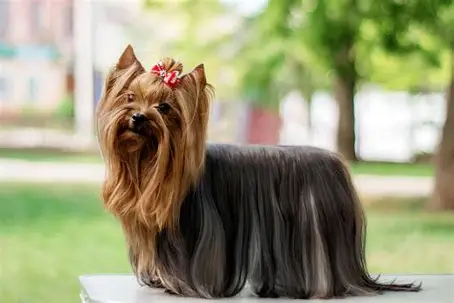
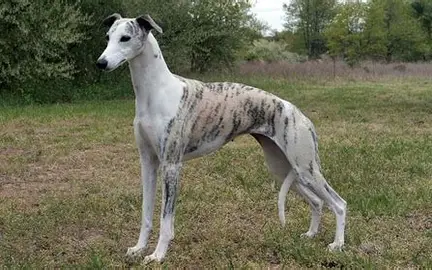
Whippet
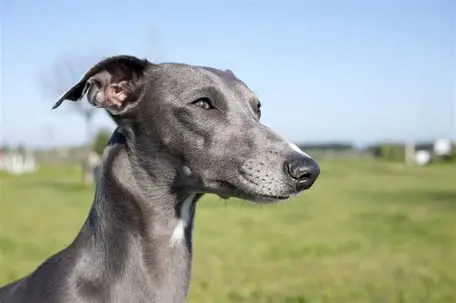
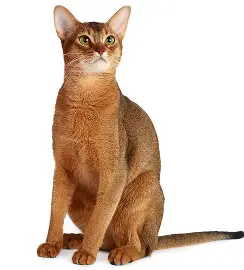
Abyssinian cat
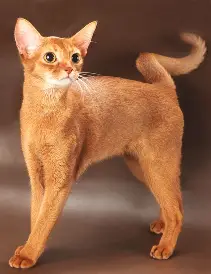
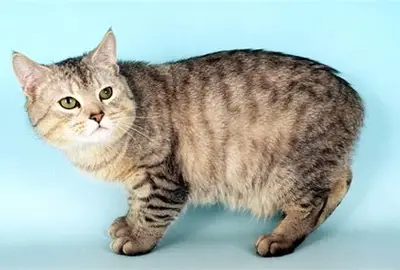
Manx cat
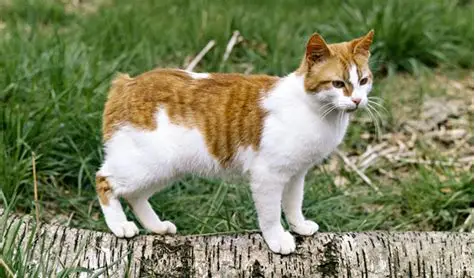
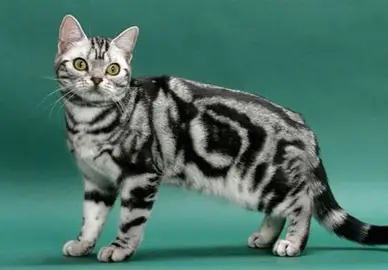
American Shorthair
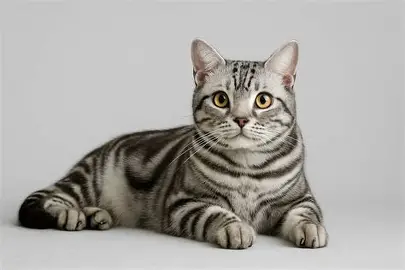
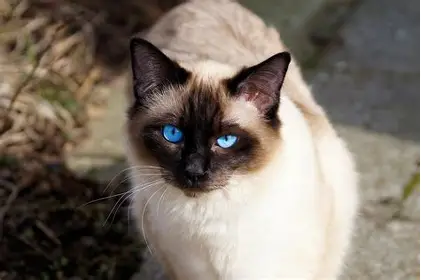
Siamese cat
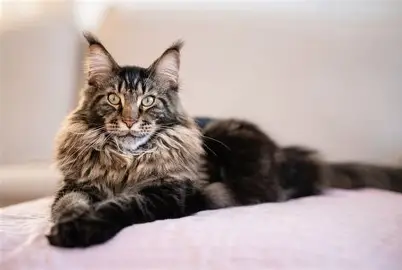
Maine Coon
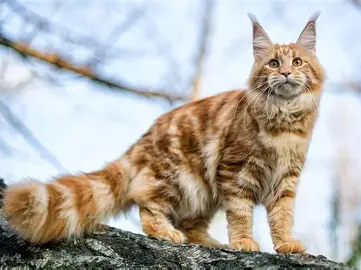
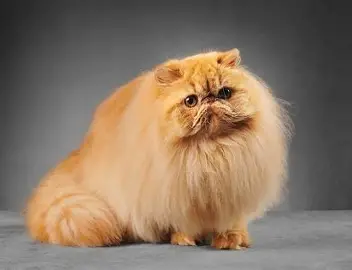
Persian
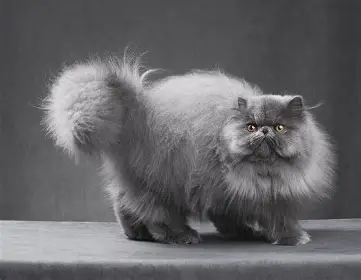
Holstein cow
Origin: Netherlands
Color: black and white, red and white (recessive)
Size: largest dairy breed
90% of all dairy cattle in the US in modern day
Milk volume produced: 1st among dairy breeds (greater than 23,000 lbs per lactation)
Milk fat: 5th among dairy breeds (greater than 3.7%)
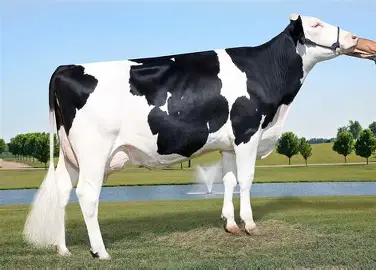

Brown Swiss
Origin: Switzerland
Color: light to dark brown
Size: large
Milk volume produced: 2nd amongst dairy breeds (greater than 22,000 lbs per lactation)
Milk fat: 3rd among dairy breeds (greater than 4.1%)
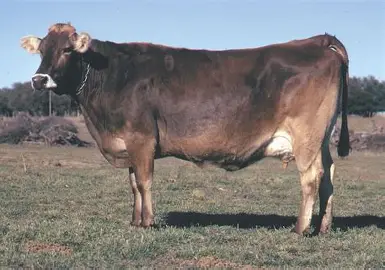
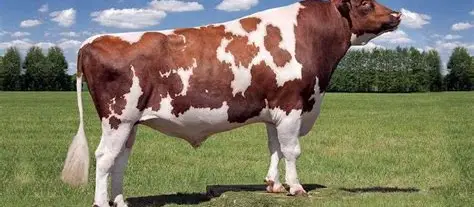
Ayrshire
Origin: Scotland
Color: mix of red, mahogany, brown, and white
Size: large
Milk volume produced: 3rd among dairy breeds (greater than 17,000 lbs per lactation)
Milk fat: 4th among dairy breeds (greater than 4%)
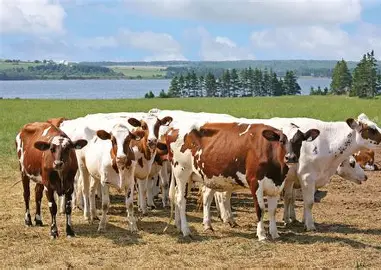
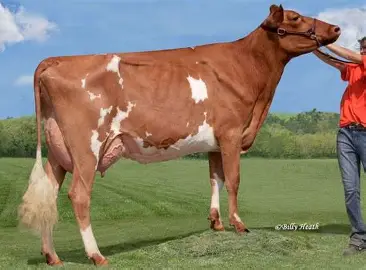
Guernsey
Origin: Island of Guernsey
Color: fawn with white markings
Size: moderate
Milk volume produced: 4th among dairy breeds (greater than 16,000 lbs per lactation)
Milk Fat: 2nd among dairy breeds (> 4.6%)
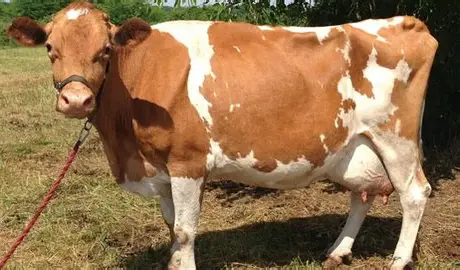
Jersey
Origin: Isle of Jersey
Color: cream to fawn and black muzzle
Size: smallest dairy breed
Milk Volume produced: 5th among dairy breeds (greater than 16,000 lbs per lactation)
Milk fat: 1st among dairy breeds (greater than or equal to 5%)
Angus Cow (beef cattle)
Origin: Scotland
Color: black (dominant)
Horns: polled (dominant)
Size: small - moderate
Traits: performs well in feedlots and produce high quality carcass with well-marbled meat

Hereford
Origin: England
Color: red body and white face
Horned
Size: large
Traits: superior foraging ability and very hardy
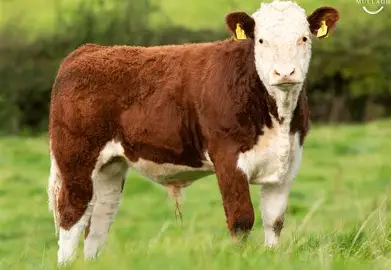
Simmental cow
Origin: Switzerland
Color: red ± white patches (black also possible)
Size: large
traits: adaptable to a range of conditions and rapid weight gain

Limousin cow
Origin: France
Color: Golden-red or black
Polled or horned
Large size
Excellent feed efficiency, adaptability, carcass yield, and fertility
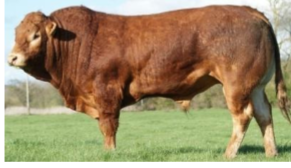
Charolais
Origin: France
Color: white
Horned
Large
Meat and draft animal, cold and heat tolerant, rapid growth
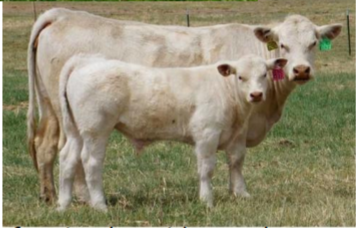
Belgian Blue cow
Origin: Belgium
Color: white, blue roan, or black
Horned
Large
Double-muscled due to mutation in myostatin gene (normally limits muscle growth) that leads to accelerated lean muscle growth and decreased fat deposition
calves usually require C-section for delivery because so muscular
Brahman Cow
Origin: India
White-gray to black to red
Horned or polled
Large
Traits: long droopy ears, large dewlap, heat-tolerant, hump at base of neck composed of muscle and connective tissue)
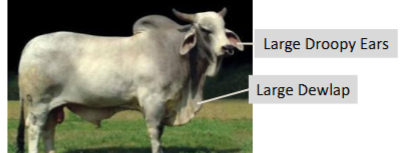
Texas Longhorn
Origin: North America
Color: multi-colored
Horned
Large size
Hardy, adaptable, lean beef
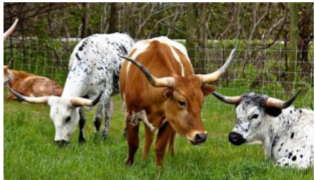
Waygu
Origin: Japan
Color: Black
Horned
Traits: intense marbling, high omega-3 and omega-6 fatty acids
Management: regular oil massages to improve fat softness and distribution,
feed beer and other foods to stimulate appetite when cattle are on high energy, low-bulk finishing ration and limited exercise to prevent mouscle toughening
Kobe beef is produced in Kobe, Japan, and is extremely high quality; can sell for more than $100
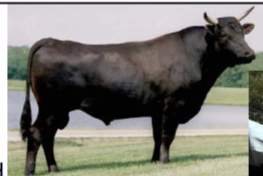
Scottish Highland
Origin: Scotland
Red is most common color, but yellow, black, dun (brown), and silver are all possible
Horned
Large
Traits: hardy and adaptable, shaggy hair coat protects eyes from insects (calves look like teddy bears)

Medium wool sheep
dorset
suffolk
cheviot
southdown
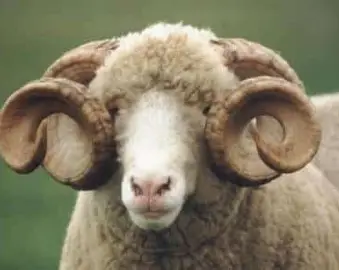
Dorset sheep
Origin: England
White face with wool down legs
Horned or polled
medium wool
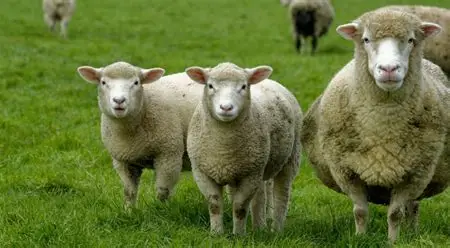
Suffolk
Origin: England
Black face and legs, white fleece
Polled (no horns)
medium wool
make excellent terminal sires for producing market lambs
purebreds have several potential inherited diseases, including spider lamb syndrome, abomasal emptying defect, and susceptibility to Scrapie
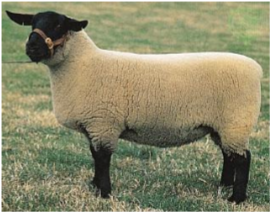
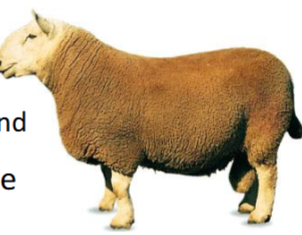
Cheviot
Origin: Scotland and England
White, bare face (no wool in front of ears), white legs
Polled
Traits: upright ears, medium, short wool, adapt well to rugged grazing areas
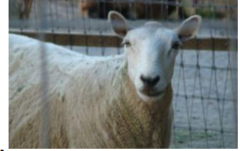
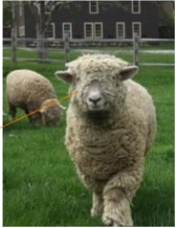
Southdown
Origin: England
Color: white, gray to light brown face and legs
Polled
Medium wool that extends down legs and over face
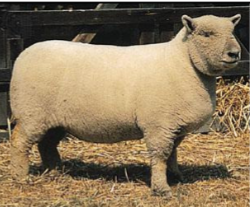
Fine wool sheep breeds
Merino
Rambouillet
Merino
Origin: Spain
Color: white
Skin folds, wool extends down legs
Horns: rams are horned, ewes are polled
Traits: High quality, fine wool, breed year-round
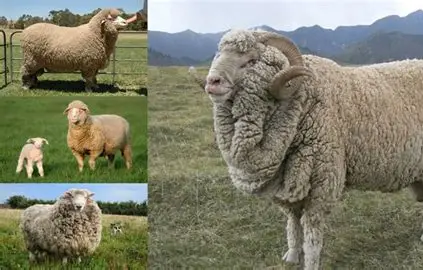
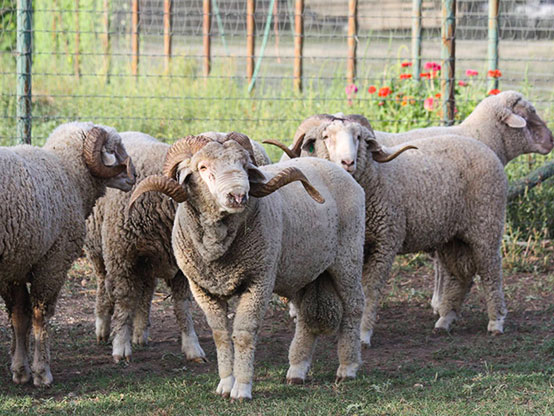
Rambouillet
Origin: France
White
Horned
Traits: high quality, fine wool, largest of the several fine wool breeds, adapts to severe conditions, extended breeding season
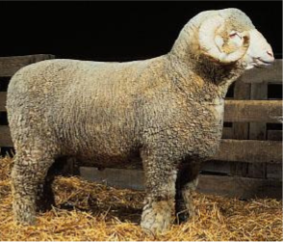
Dairy Goat Breeds (6)
Nubian
Alpine
Saanen
Toggenburg
Oberhasli
LaMancha
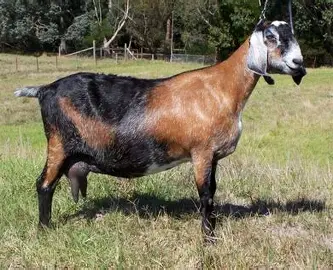
Nubian
Origin: North Africa
Color: black, tan, red, or mix
Long and droopy ears (usually white)
Horned
Traits: dairy-production
Milkfat 4-7%
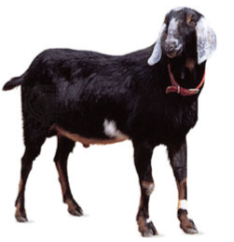
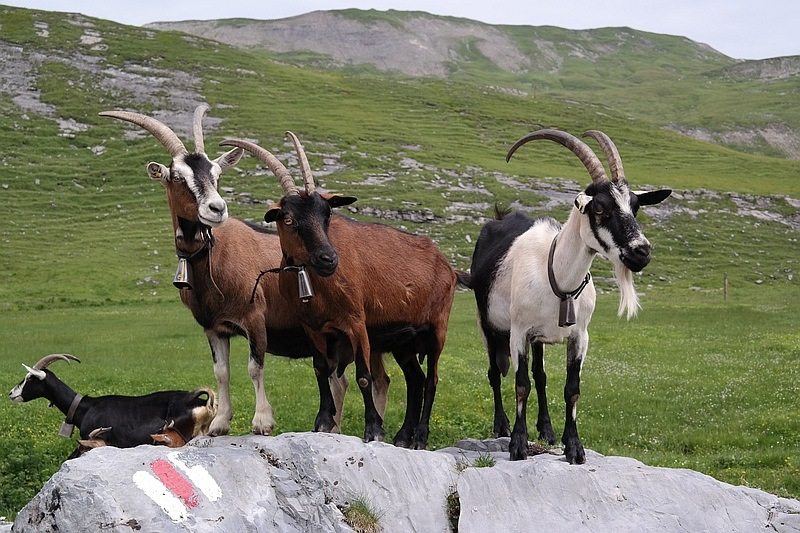
Alpine
Origin: France
Color: variety of color patterns
Upright ears
Horned
Traits: dairy-production, large and rugged
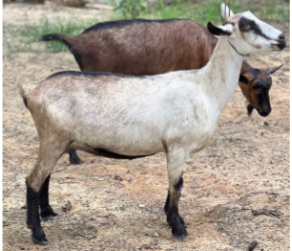
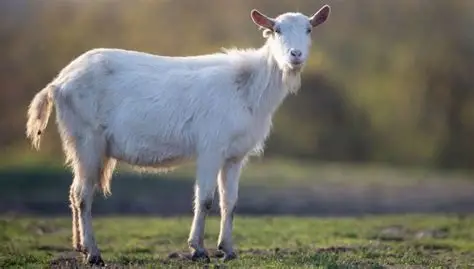
Saanen
Origin: Switzerland
Color: white
upright ears
horned
dairy production
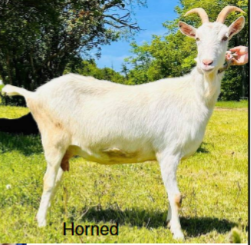
Toggenburg
Origin: Switzerland
Color: Fawn to chocolate
with white stripes on the face, white at the base of the tail and base of the ears, and
white on the legsEars: Upright ears
Horns: Horned
Traits: Dairy-production
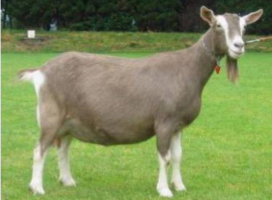
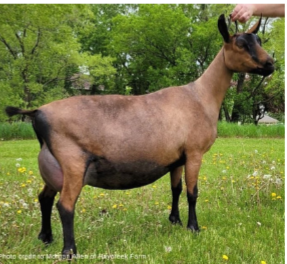
Oberhasli
Origin: Switzerland
Color: Chamois = reddish brown body with black on the legs, head, tail, and a
black stripe down the back
Ears: Upright ears
Horns: Horned or Polled
Traits: Dairy-production
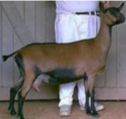
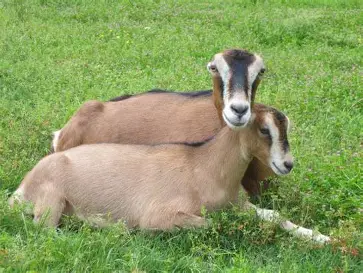
LaMancha
Origin: U.S.A.
Color: Multiple
Ears: Very short ears
Gopher ears less than or equal to 1 inch long with little to no cartilage
Elf ears less than or equal to 2 inches
Horns: Horned
Traits: Dairy-production
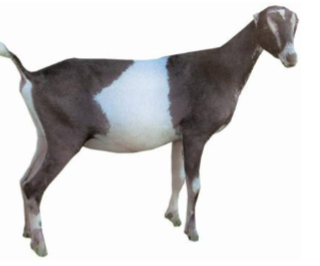
Meat goats (4)
Boer
Kiko
Spanish
Tennessee fainting
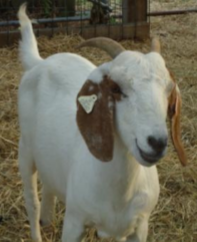
Boer
Origin: South Africa
Color: White and red
Ears: Long, droopy ears
Horns: Horned
Traits: Meat-production
“Boer” is Dutch for “Farm”
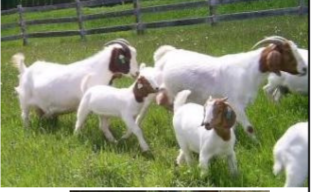
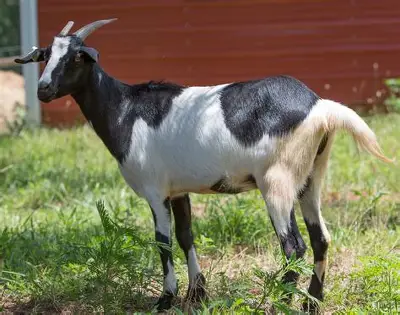
Kiko
Origin: New Zealand
Color: All colors are possible
but white is common
(dominant)
Ears: Short ears
Horns: Horned
Traits: Meat-production
Selected for survivability and weight
gain in mountain conditions
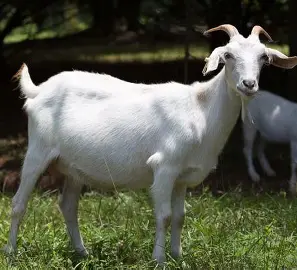
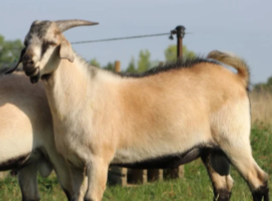
Spanish
Origin: Hardy “brush” goat of
unknown ancestry, some
of which were likely
descendants of feral goats
introduced by Spanish explorers in the 1500s
Color: Multicolor
Ears: Medium ears
Horns: Horned
Traits: Meat production
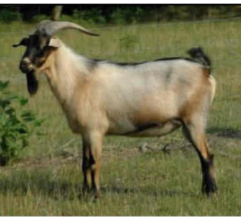
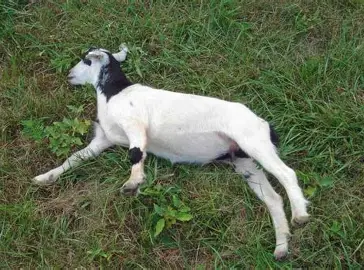
Tennessee Fainting Goat
Origin: Tennessee
Color: Multicolored
Ears: Airplane ears
Horns: Horned
Traits: Meat-production
Large frame and heavy muscled
Inherited condition: When frightened or excited, their muscles stiffen or "lock up" and they fall over and lie very
still for a few seconds. They do not lose consciousness.

Fiber Goats (2)
Angora
Cashmere
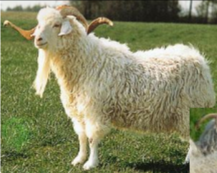
Angora
Origin: Turkey
Color: White
Ears: Droopy ears
Horns: Horned or Polled
Traits: Mohair-production
Long locks of Mohair cover body
fleece grows 6-12 inches per year
shorn twice a year
Meat-production
Control brush
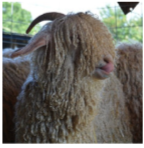
Cashmere
Cashmere = soft down or fiber from the undercoat
of non-Angora Goats.
No true breed, but goats are selectively bred for
production (ex. Kashmir goats in India & Pakistan)

Swine breeds (6)
Yorkshire
Landrace
Duroc
Hampshire
Berkshire
Tamworth
Yorkshire
Origin: England
Color: White/pink +/- freckles
Body: Long body with Upright Ears
Traits: Superior milkers, large litters, rapid growth
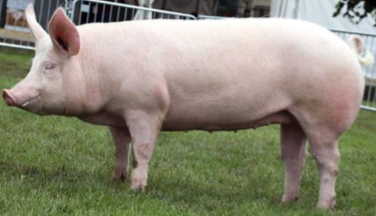
Landrace
Origin: Denmark
Color: White/pink
Body: Long body with Floppy Ears
Reproduction: Superior milkers with large litters
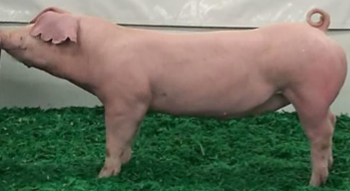
Duroc
Origin: USA
Color: Red or black
Body: Floppy Ears
Repro: Quick growth, deep body, broad ham and shoulder, and a quiet disposition
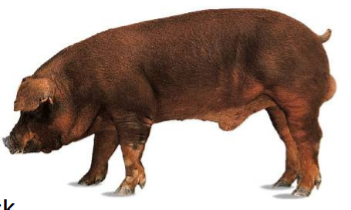
Hampshire
Origin: Kentucky - from English
breeds
Color: Black with a white belt
Body: Upright ears
Traits: Used in many cross breeding programs
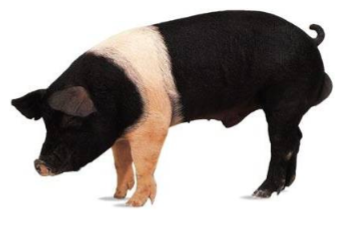
Berkshire
Origin: England
Color: Black with white on face, legs, and tail
Body: Upright Ears
Traits: Early-maturing with heavily marbled meat
Tamworth
Origin: Ireland
Color: Red
Body: Upright ears
Traits: Believed to most closely resemble the
original European forest swine breeds,
which makes them well-suited for
growing in the woods/outdoor life.

Tamworth
Origin: Ireland
Color: Red
Body: Upright ears
Traits: Believed to most closely resemble the original European forest swine breeds,
which makes them well-suited for
growing in the woods/outdoor life
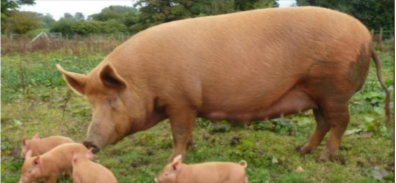
Draft horse breeds (coldbloods) (4)
Percheron
Belgian
Clydesdale
Shire
14.2-19 hands, 1400-2000 lbs, heavy, solid, strong horses with calm temperament used mainly for work and pulling loads
Percheron
Origin: France
Color: Gray or Black
Body: 15-19 hands
Heavy, solid, strong
Traits: Calm temperament
Purpose: Work; Pull loads
Most popular cart horse in the world
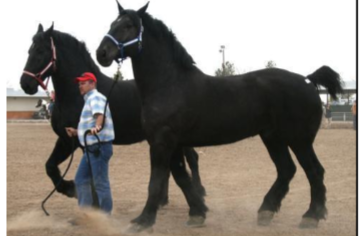
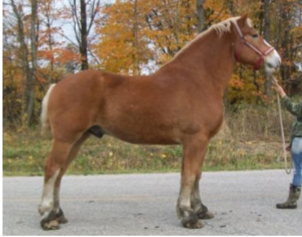
Belgian
Origin: Belgium
Color: Chestnut, bay, brown, dun, gray, or roan
Body: 16-18 hands
Heavy, solid, strong
Traits: Calm temperament
Purpose: Work; Pull loads
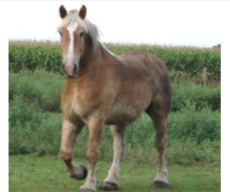
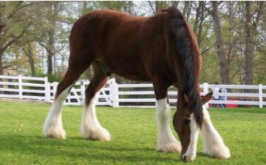
Clydesdale
Origin: Scotland
Color: Bay, brown, bay, gray, or roan
Much white on face & legs; feathers
Body: 16-19 hands
Heavy, solid, strong
Traits: Calm temperament
Purpose: Work; Pull loads
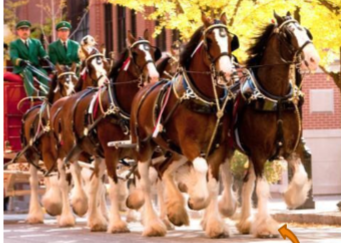
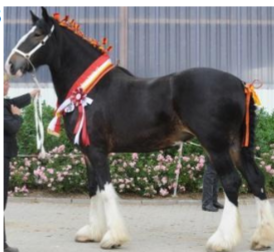
Shire
Origin: England
Color: Bay, brown, chestnut, or gray with white
markings & leg feathers
Body: Height = tallest!
Heavy, solid, strong
Traits: Calm temperament
Purpose: Work; Pull loads
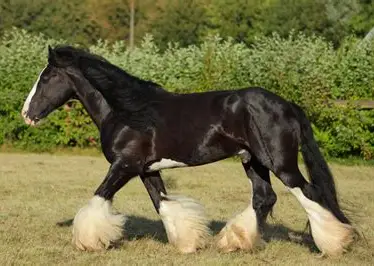
Lightbreeds (warmblooded//hotblooded) (7)
Quarter Horse
Thoroughbred
Paint
Standardbred
Appaloosa
Arabian
Morgan
14.2-17.2 hands, 900-1400 lbs, originate in Europe, Asia, South and North Americas
Riding, driving, racing, etc
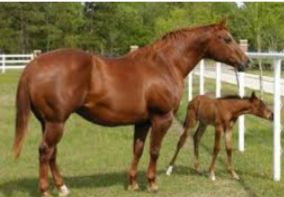
Quarter horse
Origin: United States
Color: Any solid color
Body: 15.2-16.1 hands
Traits: Muscular hindend
Purpose: Working cow horse
Fast at short distances (1/4 mile)
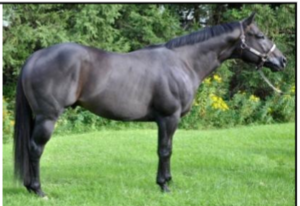
Thoroughbred
Origin: England
Color: Any
Body: 14.2-17 hands
Traits: Fast
Purpose: Race ¾ to 2 miles
Also dressage, jumping,
eventing, cross country, etc
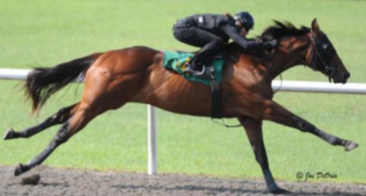
Standardbred
Origin: Spain
United States
Color: Any solid color, mostly brown, bay, black,
or chestnut
Body: 14-16 hands
Traits: Good stamina
Similar to Thoroughbreds
but often have longer
and lower bodies
Purpose: Trotter, Pacer, Carriage horse, Harness racing
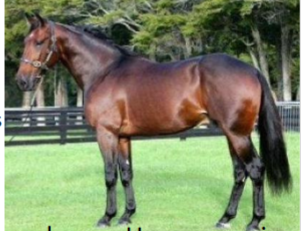
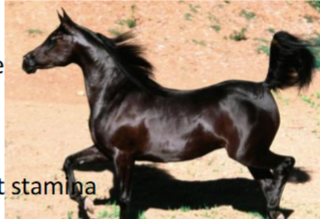
Arabian
Origin: Arabian Peninsula
Color: Bay, brown, gray,
chestnut, or black
Body: 14.3-16 hands
Dished/concave face
Large nostrils
High tail carriage
Traits: Intelligent; Great stamina
Purpose: Riding; Endurance racing
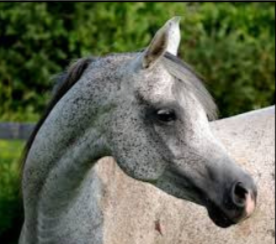
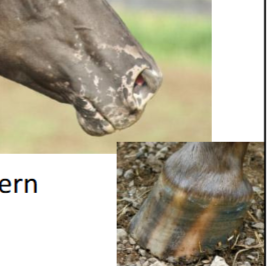
Appaloosa
Origin: United States
(likely of Spanish descent)
Color: Mottled coat and skin pattern
White sclera of eyes
Striped hooves
Body: 14-16 hands
Traits: Distinctive color pattern
Purpose: Riding and working


Morgan
Origin: United States
Color: Bay, brown,
black, or chestnut
Body: 14.1-15.3 hands
Traits: Justin Morgan started the breed from one
foundation sire in 1789 in W. Springfield, MA
Purpose: Multi-purpose: show, harness racing,
pleasure/trail riding, and driving
